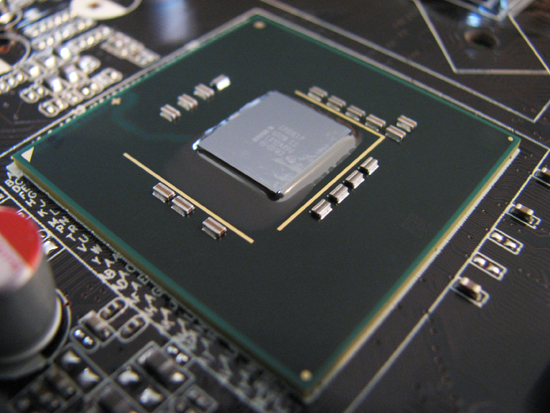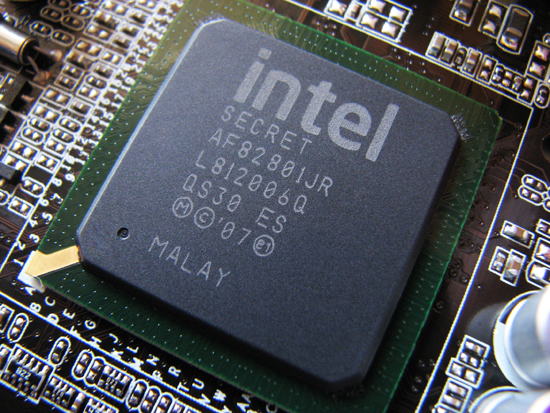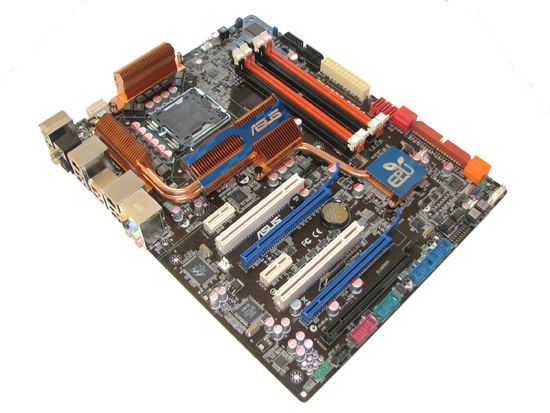ASUS P5Q3 Deluxe: An Early Preview of P45 Express Performance
by Kris Boughton on May 13, 2008 2:00 PM EST- Posted in
- Motherboards
As one of the motherboard industry's most experienced advocates of new technology, ASUS wasted no time in preparing what may be their premier Intel P45-based offering, the P5Q3 Deluxe, for near global distribution. With the long-awaited first-round availability of motherboards based on Intel's newest high-performance X48 Express chipset barely behind us, some buyers are finding themselves at yet another crossroad. This time attention is focused squarely on P45, Intel's first ever consumer chipset built using 65nm process technology. Today, choosing the right platform can be a lot like trying to take aim at a field of continually moving targets: just when you think you've figured out what's right for your next build the market shifts and something new appears on the not-too-distant horizon. As before, this has a lot of users asking if now is the right time to pick up that board they've been eyeing or if they would be better off waiting just a little while longer for the next big thing to come down the pipe.
In the past, most new chipset launches either were well timed to coincide with the release of a new system-wide feature/technology or were introduced due to the need to support the validated operation of an entirely new CPU architecture. The Intel P45 Express chipset will continue to defy this pattern, the seemingly lockstep association of CPUs and chipsets having been abandoned long ago. Intel ditched the single chipset approach awhile back giving rise to what can only be described as the continual overlapping availability of multiple chipset models at any given time. The idea is that each design is tuned for a specific market sector, with default behavior depending on the intended application and with support for certain minimum requirements. Of course, this also provides an easy way to differentiate product offerings based on the target performance segment, thereby allowing top-shelf prices for premium components.
Ultimately, all of this goes back to our initial entering argument - should I wait or should I go? With Intel's next-generation Nehalem CPU architecture due to arrive sometime in late 2008 or early 2009, P45 will offer users one last chance to upgrade before the monolithic MCH design goes the way of the dodo. As the last of its kind, P45 must be capable of standing the test of time. Given the maturity of the ICH/MCH design, we expect P45 to be very capable, and the adoption rate among OEMs should be especially high. However, it remains to be seen whether P45 will be the crowning glory of the pre-IMC (Integrated Memory Controller) chipsets, or if it will merely be the last gasp from a dying breed.
From a feature perspective, P45 brings little if anything new to the table. To our surprise, unlike X48, P45 will not boast official support for Intel's newest 1600 FSB (400 MHz) CPUs, such as the Core 2 Extreme QX9770 quad-core processor, officially topping out at 1333 FSB. The chipset has been validated for operation at up to DDR3-1333 only, with as much as 8GB of non-ECC main system memory. However, designs utilizing DDR2 will be able to make use of as much as 16GB of memory but will be limited to a maximum memory speed of DDR2-1066, unless the chipset is overclocked. Assuming inexpensive 8GB DDR2 kits (2x4GB) ever appear on the market, P45 could be quite the platform for those that are looking to run 64-bit OSes that can employ such massive amounts of installed memory.
 The Intel P45 Express chipset, seen here as a revision A2 chip, is quite a bit larger than we expected. |
In addition, P45 provides full PCI Express (PCIe) 2.0 interconnect compliance, which increases the maximum theoretical bandwidth of any installed PCIe 2.0-enabled component by twofold. However, unlike X48, P45 only provides 16 PCIe 2.0 lanes, so AMD/ATI CrossFire setups will only receive half the bandwidth relative to an X38/X48 board. How much that actually impacts dual-GPU performance is still a topic of debate, as the PCIe bandwidth generally does not seem to be the major limiting factor.
This brings us to the main difference between P35 and P45. Unlike P35, P45's Northbridge PCIe 2.0 ports can be configured for either 1x16 or 2x8 operation, which is different than past mainstream/performance segment chipsets like P35 and P965 where it was impossible to directly connect more than one graphics card to Northbridge PCIe resources. In this respect, P45 provides something new, allowing discerning gamers on a budget the opportunity to experience multi-GPU 3D graphics acceleration without the need for an absolute top-end motherboard. Given time, P45 platforms could become quite the powerhouse when it comes to assembling an inexpensive CrossFire(X) gaming system.
 The Intel ICH10R Southbridge - trust us; there are no secrets in here. |
Motherboards based on P45 are also the first to include Intel's revised I/O Controller Hub, ICH10(R). When it comes to peripheral support, we were expecting something more than what ICH10 provides. The truth is ICH10R looks a lot like ICH9R. In fact, for 99% of users they might as well be one in the same. ICH10 (the non-RAID enabled variant) adds 2 more SATA ports for a total of 6, while ICH10R remains unchanged, with support for 6 ports, just as before. Among the more popular features, AHCI support and Intel's Matrix RAID Technology also make a comeback.
In light of the lack of change, P45's saving grace may be its relatively low price, assuming vendors decide to pass their savings on to the consumer. The latest channel information shows P45 chipset prices at around $40 USD in 1000-lot quantities, with the cost of X48 chipsets still hovering near the $70 USD mark. P45 appears to be more of a manufacturing optimization than anything else as the P45 Express chipset marks the first time that Intel has mass produced such a device using 65nm process technology. A side-by-side comparison with a P35 die reveals only slight differences in size and shape, not what we expected considering the die shrink from 90nm down to 65. We can only conclude that a significant portion of the new die has been dedicated to what will become G45, the upcoming chipset variant that will feature an X4500 integrated graphics GPU. That discussion will be postponed until a later date; for now let's take a closer look at what the ASUS P5Q3 Deluxe has to offer.











30 Comments
View All Comments
cuti7399 - Thursday, August 14, 2008 - link
is this true?957004 - Thursday, May 22, 2008 - link
so it mean i will no need to buy ASUS x48 MB?Narg - Monday, May 19, 2008 - link
$250 is way too much, especially for a low end chipset board. I just bought a board for $60 that does 100% of what I need for a new Vista-64 machine with Crossfire. The MB pricing has been going through the roof lately.kjboughton - Saturday, May 24, 2008 - link
We've just received an MSRP update direct from ASUS, expect to see this board selling for about $229 with the P5Q (DDR2) variant available for about $209.Nihility - Thursday, May 15, 2008 - link
the instant on technology Asus put on this thing?Some stripped down linux distro as I understand it
Egglick - Wednesday, May 14, 2008 - link
After looking things over with the P35 added to the mix, I'm going to be completely honest here -- the P45 at any substantial premium is a load of crap.By my calculations, the performance difference between a P35 and P45 is 2-3% at most, and the majority of the time you're only talking about tenths of a percent.
When you consider that P35 boards are selling for as low as $75 now (with several from Asus going for under $100), you'd have to be nuts to pay $225+ for a difference which is hardly even worth mentioning.
Sure, you can save anywhere from 7-19 watts with the P45 (depending on the application), but you can save twice that by replacing one of your light bulbs with a compact florescent. Spend your money elsewhere.
hpram99 - Wednesday, May 14, 2008 - link
"two RJ-45 1000GBps Ethernet ports"Oh my god! I must go out and buy a hundred of these, make a super switch out of them! That's incredible, are they going to do away with SATA now that Asus made Ethernet run 300x faster?
lopri - Wednesday, May 14, 2008 - link
Well, actually I wish ASUS (and other board makers) made their board with ONE Intel Gigabit PHY, instead of two or four Marvell PHY. Heck, get rid of that EPU BS while you're at it.hooflung - Wednesday, May 14, 2008 - link
I want to get excited. I really do. But as an owner of a Gigabyte P965 DS3 I just can't get aroused. My e4300 still is clocking strong at 3.0ghz. There isn't enough speed to justify going .45nm just to hit 3.8 - 4.0ghz and also having to go to DDR3. Even if they release a DDR2 board its likely is it going to be worth buying a new board or just installing a 'beta' bios on my current setup if I did want to get a .45nm chip.Just seems Intel wants to go out with a bang and also have more unload options for their C2Ds when they switch platforms within the next year.
If I was buying new, I'd be really tempted but good ol' faithful P965 is running 1 year strong on a mild OC 'according to today's standards of OCing.'
Stele - Wednesday, May 14, 2008 - link
[quote]The P5Q3 may report the use of a 16-phase PWM but we know better. [/quote]Do we, really?
[quote]Although ASUS design engineers have added a lot of extra chokes and MOSFETS, the overall capacity of the power delivery circuit remains comparable to their competitors' more modest 8-phase designs.[/quote]
From the review we don't know what components Asus used in its PWM design (MOSFETs, drivers etc) - heck, we don't even know what PWM controller they have there. It could be the same ADP3198 4-phase controller Asus had been using for some time, or it could be a newer, improved one - especially considering that Analog transferred much of its CPU PWM controller range to ON Semiconductor late last year.
We don't have figures from Asus engineers. We also did not examine the circuitry's layout, overally efficiency, transient response, peak and sustained load-handling capabilities ... nothing of the sort, yet we're prepared to come to a positive conclusion regarding the capabilities and quality of the circuitry, and indeed compare it with others. An educated guess, based on some evidence to back it up, would've probably been more appropriate. IMHO it's not exactly fair (or professional) to jump to such a conclusion with merely an assertion without any substantiation to support it. That's expected from readers who can only look at the product and play the armchair general, but not from reviewers who actually have the product and can (and should) do what they can to properly assess it for the benefit of said readers.
As for the rest of the review, it was certainly interesting; however correct me if I'm wrong, but it seems that ICH10/R is supposed to bring rather more to the table than just 2 more SATA ports plus AHCI capabilities for the non-R version. For instance, apparently a 10GbE MAC is integrated as well.
However, as with the ICH9's integrated GbE MAC, many manufacturers may balk at having to use specific (particularly, i8256x) Intel PHYs in order to make use of that MAC, since it requires a PHY that supports Intel's GLCI/LCI bus. Instead, manufacturers may choose to provide the usual PCIe/PCI controllers that they've normally been using, to keep inventory and costs under control (such controllers can be used on AMD platform products, for example). Perhaps the same proprietary-PHY issues might plague implementation of ICH10's rumoured Wi-Fi capabilities as well... all in all, then, it does seem that as far as the end user of actual motherboard products is concerned, there would apparently be very little that's new with the ICH10. IMHO, Intel could've added more PCIe lanes, which would probably have been better appreciated.
Speaking of PCIe lanes, that's probably one reason Asus chose to stick with USB for the wireless module. USB does the job well enough - if it ain't broken, why fix it? PCIe x1 is overkill and ICH10 is already in dire shortage of lanes, with 1 going to network (2 for dual-NIC motherboards), 1 or 2 going to PCIe x1 slots and just 4 left to go to the third graphics card x16 slot. With the abundance of USB ports that ICH9 and 10 provide, Asus probably figured that using one for the wireless module can't hurt. And if anything it's probably to do with inventory and ease of design as well, since Asus does make wireless USB adapters - you could use the same basic circuit design and fit it with a motherboard USB connector and external antenna interface - voila, wireless for motherboards.
At least Anandtech did not help perpetuate the unconfirmed (and unlikely) rumour that ICH10 eliminates legacy ports like PS/2, parallel, serial, game/MIDI and so on - since those ports have little to do with the south bridge at all. These legacy ports connect to Super I/O chips, which on modern motherboards is also the H/W monitoring IC, and which in turn connect to the south bridge via the LPC interface. Thus the only way an ICH could completely remove support for legacy ports in current motherboard architectures would be to remove the LPC bus - which would also remove H/W monitoring as well as BIOS, unless it's part of Intel's force-forward plan to move to SPI for BIOS, a la RDRAM and PATA. That still leaves H/W monitoring high and dry though.
On another note, as others here (especially Frumious1) have commented, it would be good to compared Intel chipsets from, say, P965 through P45 to see what improvements P45 brings. Perhaps some useful metrics would be performance tests for memory (read/write/copy/latency/overclockability), CrossFire (x8,x8 on P45 vs x8,x8 using a PCIe switch IC vs 16,x4 etc), disk and USB subsystems (read/write/copy/copy across ports), power consumption. Oh and please have all the tested boards participate in all tests, so that there's a complete comparison across the board.
Admittedly, power consumption is the trickiest of them all because each generation of motherboards have different components and/or different features (e.g. one has FireWire while another doesn't, or one uses a FireWire controller from Agere while another uses one from VIA etc). Perhaps we could try disabling all such external controllers in BIOS and seeing if that makes a difference to power consumption (ie whether the option turns the controllers off or merely disconnects them) then, if turning them off does work, test the boards with all external options disabled. That, at least, minimises variables to board layout and CPU/MCH/ICH/RAM power circuitry subsystems - which would be useful metrics themselves. Just a suggestion!